Plasmid pPCP1-derived sRNA HmsA promotes biofilm formation of Yersinia pestis
- PMID: 27492011
- PMCID: PMC4973556
- DOI: 10.1186/s12866-016-0793-5
Plasmid pPCP1-derived sRNA HmsA promotes biofilm formation of Yersinia pestis
Abstract
Background: The ability of Yersinia pestis to form a biofilm is an important characteristic in flea transmission of this pathogen. Y. pestis laterally acquired two plasmids (pPCP1and pMT1) and the ability to form biofilms when it evolved from Yersinia pseudotuberculosis. Small regulatory RNAs (sRNAs) are thought to play a crucial role in the processes of biofilm formation and pathogenesis.
Results: A pPCP1-derived sRNA HmsA (also known as sR084) was found to contribute to the enhanced biofilm formation phenotype of Y. pestis. The concentration of c-di-GMP was significantly reduced upon deletion of the hmsA gene in Y. pestis. The abundance of mRNA transcripts determining exopolysaccharide production, crucial for biofilm formation, was measured by primer extension, RT-PCR and lacZ transcriptional fusion assays in the wild-type and hmsA mutant strains. HmsA positively regulated biofilm synthesis-associated genes (hmsHFRS, hmsT and hmsCDE), but had no regulatory effect on the biofilm degradation-associated gene hmsP. Interestingly, the recently identified biofilm activator sRNA, HmsB, was rapidly degraded in the hmsA deletion mutant. Two genes (rovM and rovA) functioning as biofilm regulators were also found to be regulated by HmsA, whose regulatory effects were consistent with the HmsA-mediated biofilm phenotype.
Conclusion: HmsA potentially functions as an activator of biofilm formation in Y. pestis, implying that sRNAs encoded on the laterally acquired plasmids might be involved in the chromosome-based regulatory networks implicated in Y. pestis-specific physiological processes.
Figures
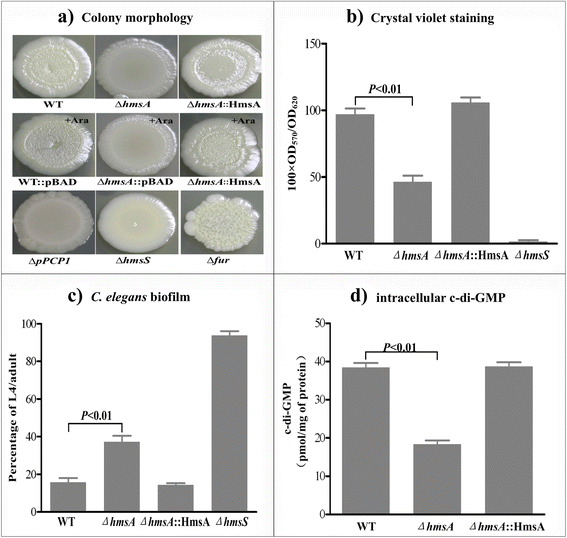
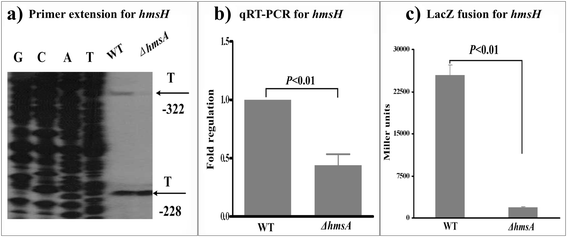
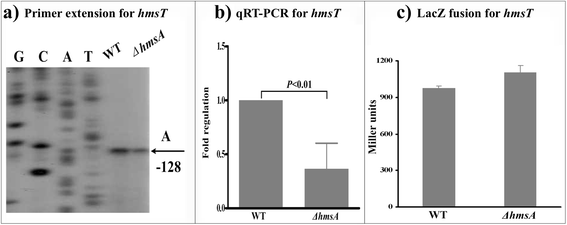
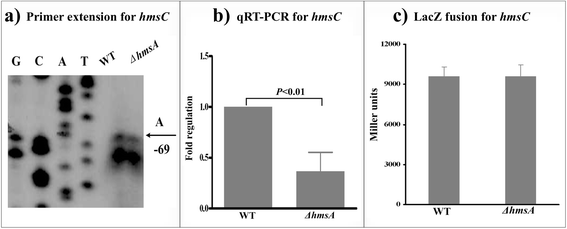
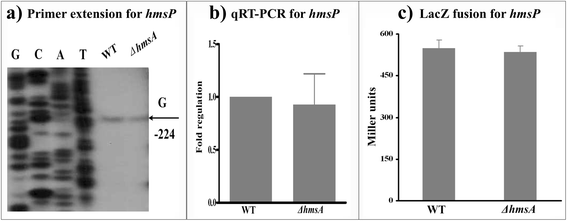
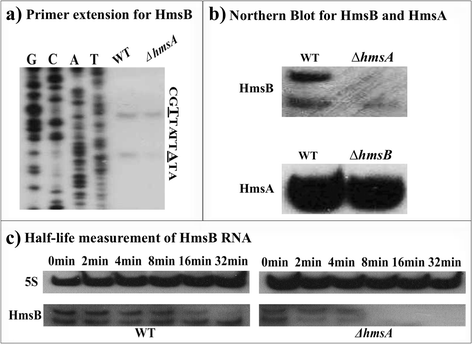
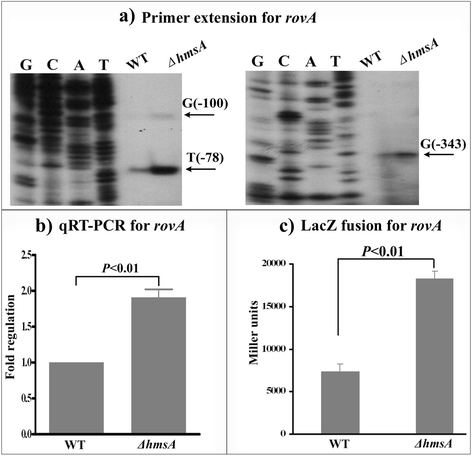
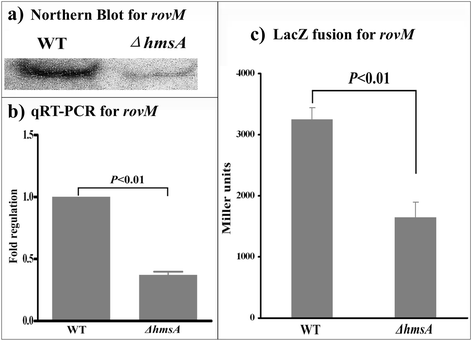

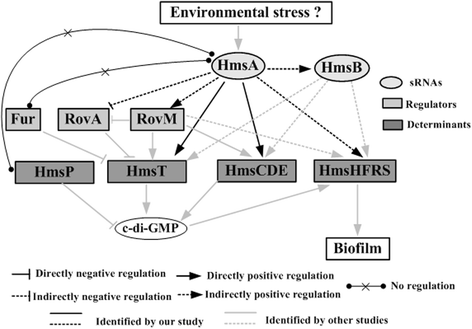
Similar articles
-
Altered Yersinia pestis virulence is associated with the small regulatory RNA HmsA encoded on the plasmid pPCP1.Future Microbiol. 2020 Sep;15:1207-1215. doi: 10.2217/fmb-2019-0319. Future Microbiol. 2020. PMID: 33026884
-
Reciprocal regulation of Yersinia pestis biofilm formation and virulence by RovM and RovA.Open Biol. 2016 Mar;6(3):150198. doi: 10.1098/rsob.150198. Open Biol. 2016. PMID: 26984293 Free PMC article.
-
Fur is a repressor of biofilm formation in Yersinia pestis.PLoS One. 2012;7(12):e52392. doi: 10.1371/journal.pone.0052392. Epub 2012 Dec 21. PLoS One. 2012. PMID: 23285021 Free PMC article.
-
[Regulation of c-di-GMP metabolism and biofilm formation in Yersinia pestis].Sheng Wu Gong Cheng Xue Bao. 2017 Sep 25;33(9):1513-1524. doi: 10.13345/j.cjb.170073. Sheng Wu Gong Cheng Xue Bao. 2017. PMID: 28956397 Review. Chinese.
-
Transcriptional regulation of Yersinia pestis biofilm formation.Microb Pathog. 2019 Jun;131:212-217. doi: 10.1016/j.micpath.2019.04.011. Epub 2019 Apr 10. Microb Pathog. 2019. PMID: 30980880 Review.
Cited by
-
Cpx-signalling facilitates Hms-dependent biofilm formation by Yersinia pseudotuberculosis.NPJ Biofilms Microbiomes. 2022 Mar 29;8(1):13. doi: 10.1038/s41522-022-00281-4. NPJ Biofilms Microbiomes. 2022. PMID: 35351893 Free PMC article.
-
Transcriptional Regulation Between the Two Global Regulators RovA and CRP in Yersinia pestis biovar Microtus.Curr Microbiol. 2018 Dec;75(12):1634-1641. doi: 10.1007/s00284-018-1571-4. Epub 2018 Oct 5. Curr Microbiol. 2018. PMID: 30291406
-
Molecular and Genetic Mechanisms That Mediate Transmission of Yersinia pestis by Fleas.Biomolecules. 2021 Feb 3;11(2):210. doi: 10.3390/biom11020210. Biomolecules. 2021. PMID: 33546271 Free PMC article. Review.
-
Targeting the Holy Triangle of Quorum Sensing, Biofilm Formation, and Antibiotic Resistance in Pathogenic Bacteria.Microorganisms. 2022 Jun 16;10(6):1239. doi: 10.3390/microorganisms10061239. Microorganisms. 2022. PMID: 35744757 Free PMC article. Review.
-
The Plasmid pEX18Gm Indirectly Increases Caenorhabditis elegans Fecundity by Accelerating Bacterial Methionine Synthesis.Int J Mol Sci. 2022 Apr 30;23(9):5003. doi: 10.3390/ijms23095003. Int J Mol Sci. 2022. PMID: 35563392 Free PMC article.
References
-
- Erickson DL, Jarrett CO, Wren BW, Hinnebusch BJ. Serotype differences and lack of biofilm formation characterize Yersinia pseudotuberculosis infection of the Xenopsylla cheopis flea vector of Yersinia pestis. J Bacteriol. 2006;188(3):1113–9. doi: 10.1128/JB.188.3.1113-1119.2006. - DOI - PMC - PubMed
MeSH terms
Substances
LinkOut - more resources
Full Text Sources
Other Literature Sources

